The Employment Prospects for UK Graduates
VerifiedAdded on 2023/05/30
|14
|2668
|193
AI Summary
This study evaluates the employment prospects for UK graduates, analyzing the labour market trends and needs of graduates to develop their performance and productivity level. It also discusses the benefits of obtaining a degree and whether they exceed the cost.
Contribute Materials
Your contribution can guide someone’s learning journey. Share your
documents today.
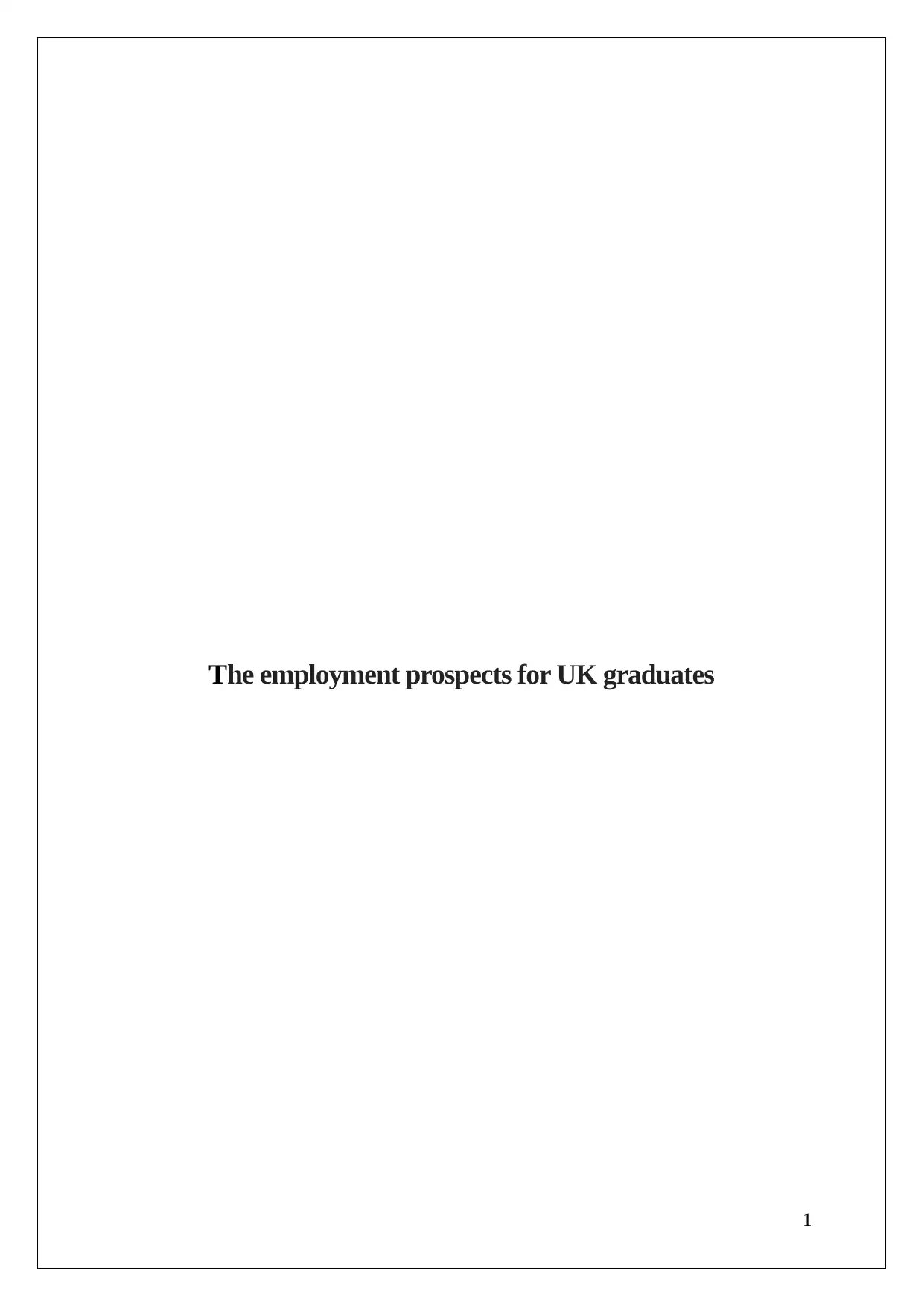
The employment prospects for UK graduates
1
1
Secure Best Marks with AI Grader
Need help grading? Try our AI Grader for instant feedback on your assignments.
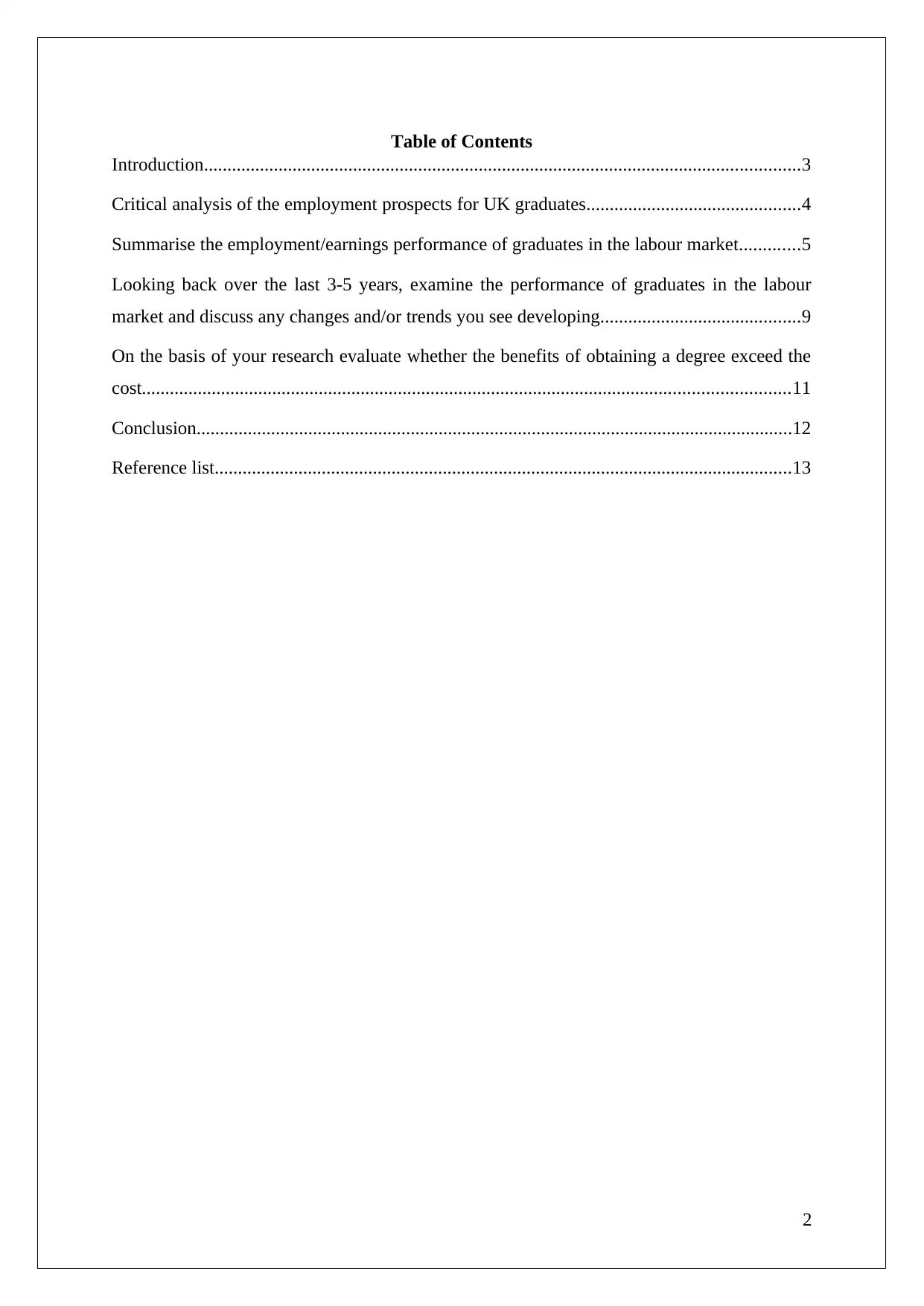
Table of Contents
Introduction................................................................................................................................3
Critical analysis of the employment prospects for UK graduates..............................................4
Summarise the employment/earnings performance of graduates in the labour market.............5
Looking back over the last 3-5 years, examine the performance of graduates in the labour
market and discuss any changes and/or trends you see developing...........................................9
On the basis of your research evaluate whether the benefits of obtaining a degree exceed the
cost...........................................................................................................................................11
Conclusion................................................................................................................................12
Reference list............................................................................................................................13
2
Introduction................................................................................................................................3
Critical analysis of the employment prospects for UK graduates..............................................4
Summarise the employment/earnings performance of graduates in the labour market.............5
Looking back over the last 3-5 years, examine the performance of graduates in the labour
market and discuss any changes and/or trends you see developing...........................................9
On the basis of your research evaluate whether the benefits of obtaining a degree exceed the
cost...........................................................................................................................................11
Conclusion................................................................................................................................12
Reference list............................................................................................................................13
2
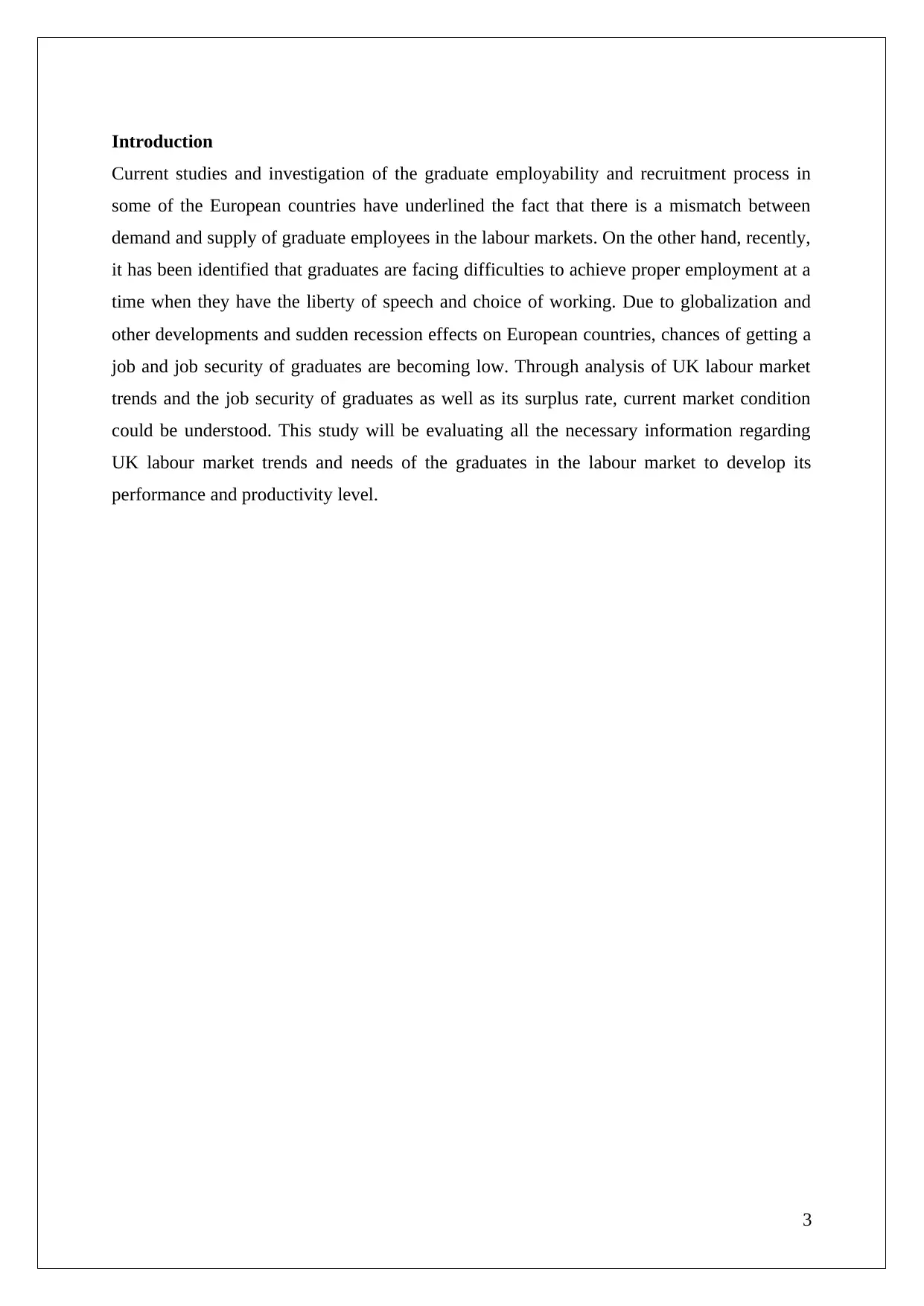
Introduction
Current studies and investigation of the graduate employability and recruitment process in
some of the European countries have underlined the fact that there is a mismatch between
demand and supply of graduate employees in the labour markets. On the other hand, recently,
it has been identified that graduates are facing difficulties to achieve proper employment at a
time when they have the liberty of speech and choice of working. Due to globalization and
other developments and sudden recession effects on European countries, chances of getting a
job and job security of graduates are becoming low. Through analysis of UK labour market
trends and the job security of graduates as well as its surplus rate, current market condition
could be understood. This study will be evaluating all the necessary information regarding
UK labour market trends and needs of the graduates in the labour market to develop its
performance and productivity level.
3
Current studies and investigation of the graduate employability and recruitment process in
some of the European countries have underlined the fact that there is a mismatch between
demand and supply of graduate employees in the labour markets. On the other hand, recently,
it has been identified that graduates are facing difficulties to achieve proper employment at a
time when they have the liberty of speech and choice of working. Due to globalization and
other developments and sudden recession effects on European countries, chances of getting a
job and job security of graduates are becoming low. Through analysis of UK labour market
trends and the job security of graduates as well as its surplus rate, current market condition
could be understood. This study will be evaluating all the necessary information regarding
UK labour market trends and needs of the graduates in the labour market to develop its
performance and productivity level.
3
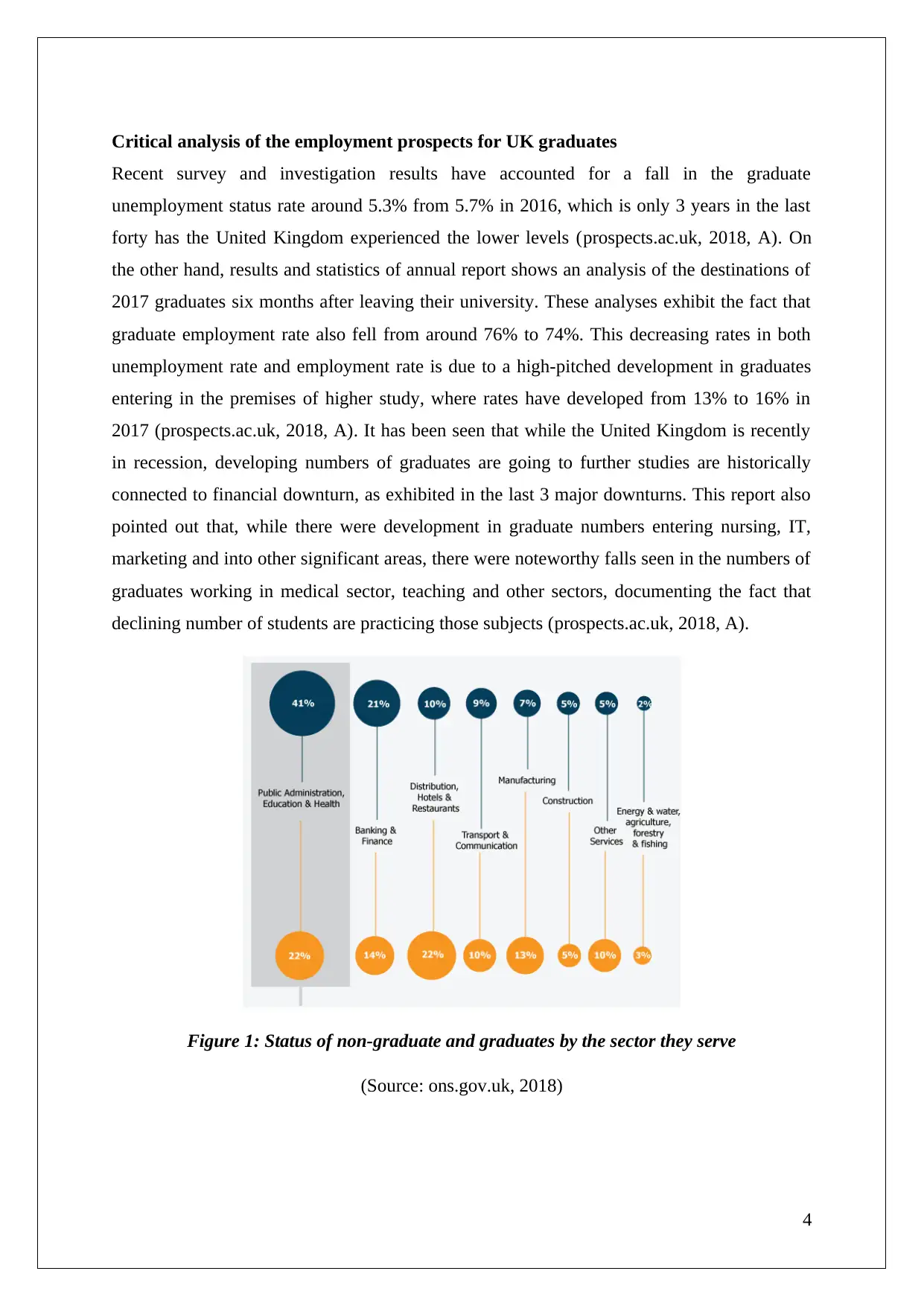
Critical analysis of the employment prospects for UK graduates
Recent survey and investigation results have accounted for a fall in the graduate
unemployment status rate around 5.3% from 5.7% in 2016, which is only 3 years in the last
forty has the United Kingdom experienced the lower levels (prospects.ac.uk, 2018, A). On
the other hand, results and statistics of annual report shows an analysis of the destinations of
2017 graduates six months after leaving their university. These analyses exhibit the fact that
graduate employment rate also fell from around 76% to 74%. This decreasing rates in both
unemployment rate and employment rate is due to a high-pitched development in graduates
entering in the premises of higher study, where rates have developed from 13% to 16% in
2017 (prospects.ac.uk, 2018, A). It has been seen that while the United Kingdom is recently
in recession, developing numbers of graduates are going to further studies are historically
connected to financial downturn, as exhibited in the last 3 major downturns. This report also
pointed out that, while there were development in graduate numbers entering nursing, IT,
marketing and into other significant areas, there were noteworthy falls seen in the numbers of
graduates working in medical sector, teaching and other sectors, documenting the fact that
declining number of students are practicing those subjects (prospects.ac.uk, 2018, A).
Figure 1: Status of non-graduate and graduates by the sector they serve
(Source: ons.gov.uk, 2018)
4
Recent survey and investigation results have accounted for a fall in the graduate
unemployment status rate around 5.3% from 5.7% in 2016, which is only 3 years in the last
forty has the United Kingdom experienced the lower levels (prospects.ac.uk, 2018, A). On
the other hand, results and statistics of annual report shows an analysis of the destinations of
2017 graduates six months after leaving their university. These analyses exhibit the fact that
graduate employment rate also fell from around 76% to 74%. This decreasing rates in both
unemployment rate and employment rate is due to a high-pitched development in graduates
entering in the premises of higher study, where rates have developed from 13% to 16% in
2017 (prospects.ac.uk, 2018, A). It has been seen that while the United Kingdom is recently
in recession, developing numbers of graduates are going to further studies are historically
connected to financial downturn, as exhibited in the last 3 major downturns. This report also
pointed out that, while there were development in graduate numbers entering nursing, IT,
marketing and into other significant areas, there were noteworthy falls seen in the numbers of
graduates working in medical sector, teaching and other sectors, documenting the fact that
declining number of students are practicing those subjects (prospects.ac.uk, 2018, A).
Figure 1: Status of non-graduate and graduates by the sector they serve
(Source: ons.gov.uk, 2018)
4
Secure Best Marks with AI Grader
Need help grading? Try our AI Grader for instant feedback on your assignments.
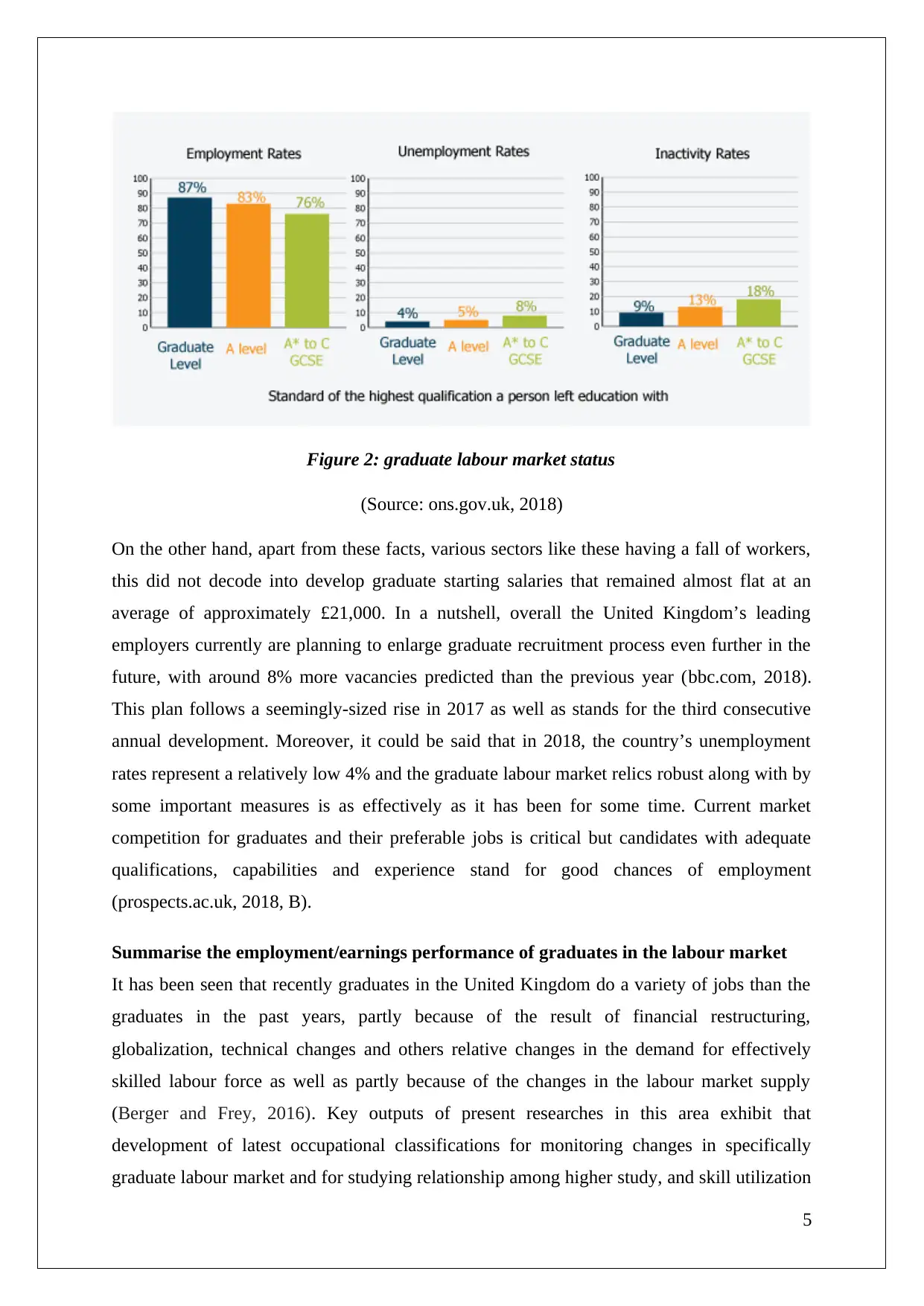
Figure 2: graduate labour market status
(Source: ons.gov.uk, 2018)
On the other hand, apart from these facts, various sectors like these having a fall of workers,
this did not decode into develop graduate starting salaries that remained almost flat at an
average of approximately £21,000. In a nutshell, overall the United Kingdom’s leading
employers currently are planning to enlarge graduate recruitment process even further in the
future, with around 8% more vacancies predicted than the previous year (bbc.com, 2018).
This plan follows a seemingly-sized rise in 2017 as well as stands for the third consecutive
annual development. Moreover, it could be said that in 2018, the country’s unemployment
rates represent a relatively low 4% and the graduate labour market relics robust along with by
some important measures is as effectively as it has been for some time. Current market
competition for graduates and their preferable jobs is critical but candidates with adequate
qualifications, capabilities and experience stand for good chances of employment
(prospects.ac.uk, 2018, B).
Summarise the employment/earnings performance of graduates in the labour market
It has been seen that recently graduates in the United Kingdom do a variety of jobs than the
graduates in the past years, partly because of the result of financial restructuring,
globalization, technical changes and others relative changes in the demand for effectively
skilled labour force as well as partly because of the changes in the labour market supply
(Berger and Frey, 2016). Key outputs of present researches in this area exhibit that
development of latest occupational classifications for monitoring changes in specifically
graduate labour market and for studying relationship among higher study, and skill utilization
5
(Source: ons.gov.uk, 2018)
On the other hand, apart from these facts, various sectors like these having a fall of workers,
this did not decode into develop graduate starting salaries that remained almost flat at an
average of approximately £21,000. In a nutshell, overall the United Kingdom’s leading
employers currently are planning to enlarge graduate recruitment process even further in the
future, with around 8% more vacancies predicted than the previous year (bbc.com, 2018).
This plan follows a seemingly-sized rise in 2017 as well as stands for the third consecutive
annual development. Moreover, it could be said that in 2018, the country’s unemployment
rates represent a relatively low 4% and the graduate labour market relics robust along with by
some important measures is as effectively as it has been for some time. Current market
competition for graduates and their preferable jobs is critical but candidates with adequate
qualifications, capabilities and experience stand for good chances of employment
(prospects.ac.uk, 2018, B).
Summarise the employment/earnings performance of graduates in the labour market
It has been seen that recently graduates in the United Kingdom do a variety of jobs than the
graduates in the past years, partly because of the result of financial restructuring,
globalization, technical changes and others relative changes in the demand for effectively
skilled labour force as well as partly because of the changes in the labour market supply
(Berger and Frey, 2016). Key outputs of present researches in this area exhibit that
development of latest occupational classifications for monitoring changes in specifically
graduate labour market and for studying relationship among higher study, and skill utilization
5
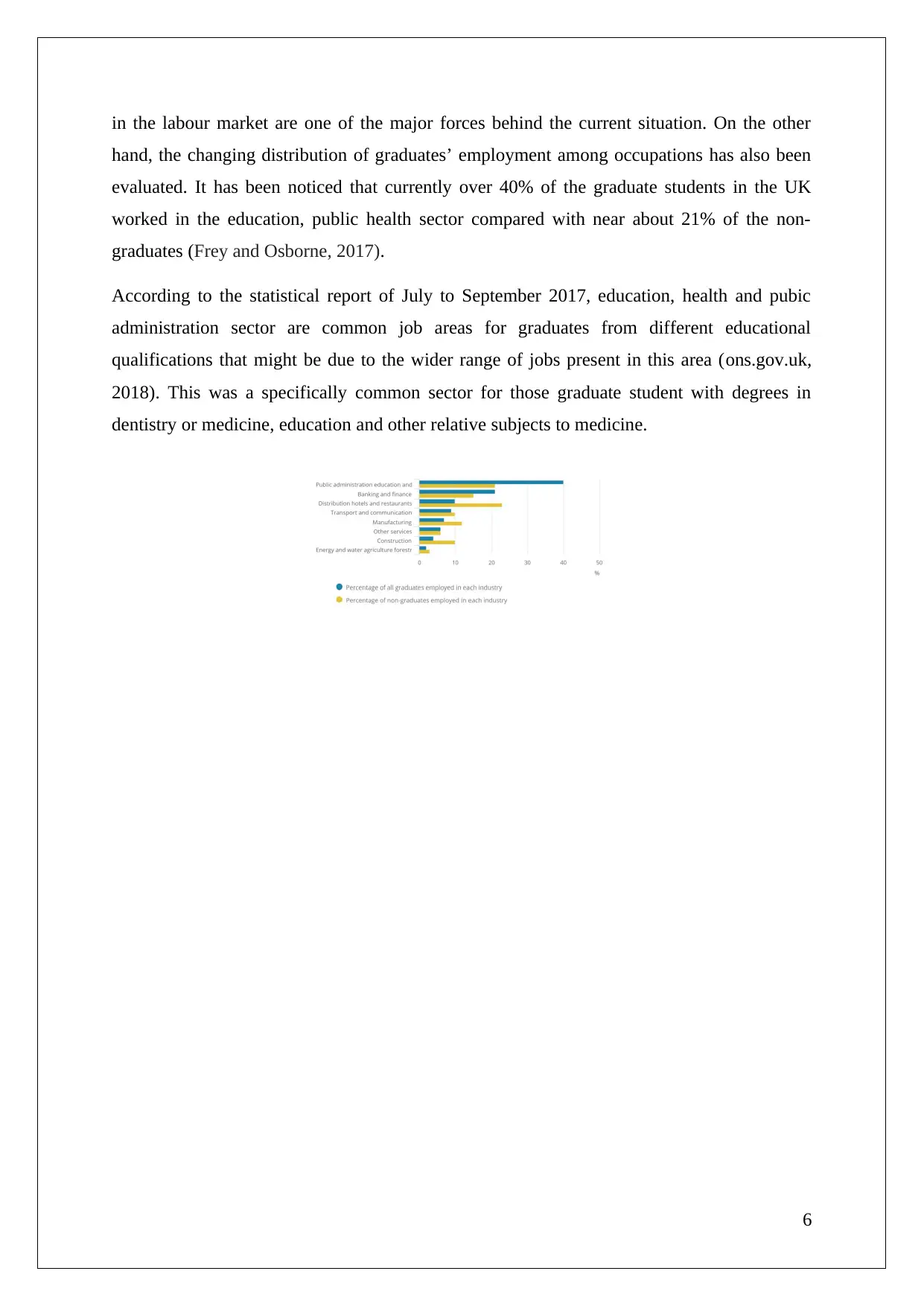
in the labour market are one of the major forces behind the current situation. On the other
hand, the changing distribution of graduates’ employment among occupations has also been
evaluated. It has been noticed that currently over 40% of the graduate students in the UK
worked in the education, public health sector compared with near about 21% of the non-
graduates (Frey and Osborne, 2017).
According to the statistical report of July to September 2017, education, health and pubic
administration sector are common job areas for graduates from different educational
qualifications that might be due to the wider range of jobs present in this area (ons.gov.uk,
2018). This was a specifically common sector for those graduate student with degrees in
dentistry or medicine, education and other relative subjects to medicine.
6
hand, the changing distribution of graduates’ employment among occupations has also been
evaluated. It has been noticed that currently over 40% of the graduate students in the UK
worked in the education, public health sector compared with near about 21% of the non-
graduates (Frey and Osborne, 2017).
According to the statistical report of July to September 2017, education, health and pubic
administration sector are common job areas for graduates from different educational
qualifications that might be due to the wider range of jobs present in this area (ons.gov.uk,
2018). This was a specifically common sector for those graduate student with degrees in
dentistry or medicine, education and other relative subjects to medicine.
6
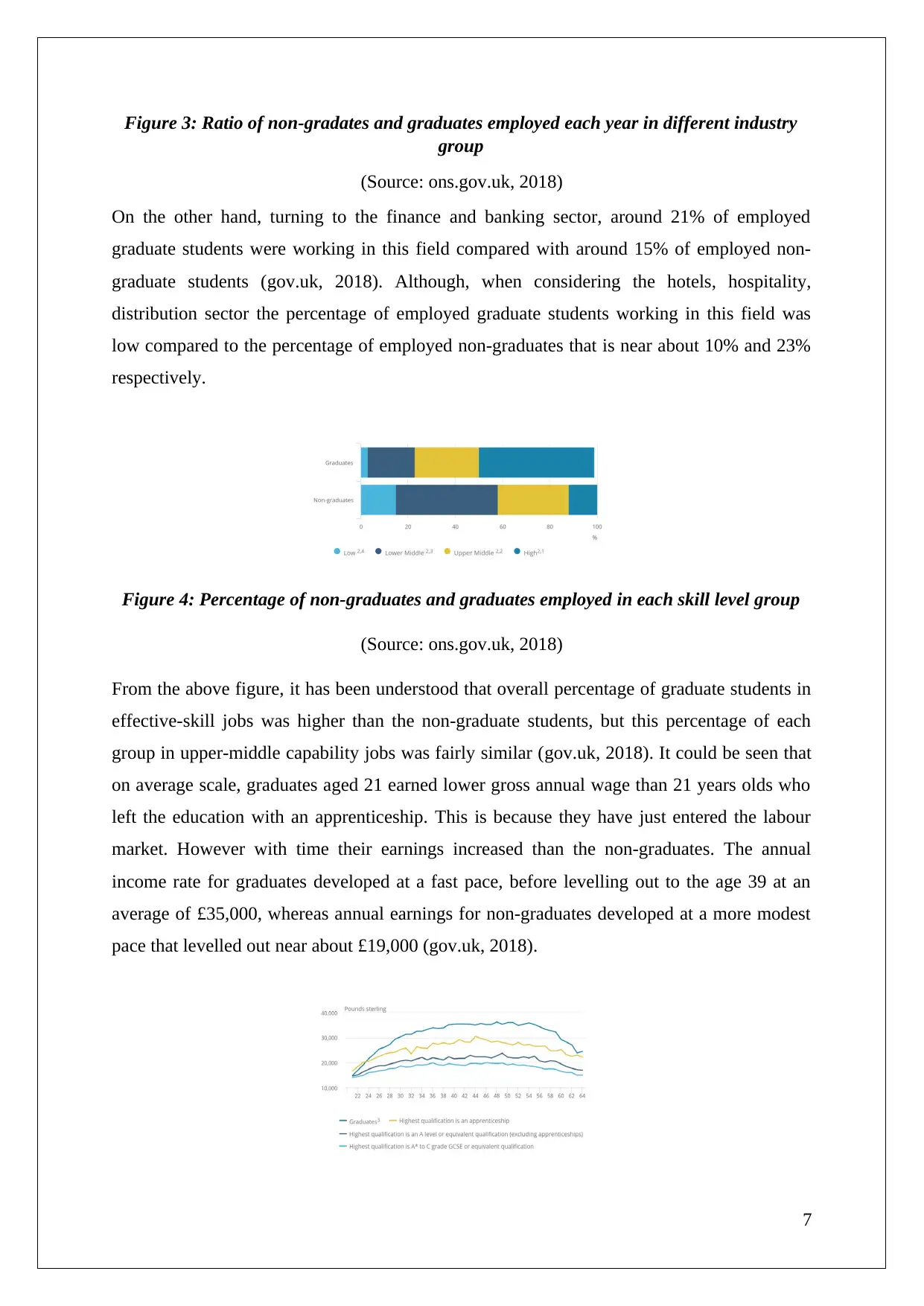
Figure 3: Ratio of non-gradates and graduates employed each year in different industry
group
(Source: ons.gov.uk, 2018)
On the other hand, turning to the finance and banking sector, around 21% of employed
graduate students were working in this field compared with around 15% of employed non-
graduate students (gov.uk, 2018). Although, when considering the hotels, hospitality,
distribution sector the percentage of employed graduate students working in this field was
low compared to the percentage of employed non-graduates that is near about 10% and 23%
respectively.
Figure 4: Percentage of non-graduates and graduates employed in each skill level group
(Source: ons.gov.uk, 2018)
From the above figure, it has been understood that overall percentage of graduate students in
effective-skill jobs was higher than the non-graduate students, but this percentage of each
group in upper-middle capability jobs was fairly similar (gov.uk, 2018). It could be seen that
on average scale, graduates aged 21 earned lower gross annual wage than 21 years olds who
left the education with an apprenticeship. This is because they have just entered the labour
market. However with time their earnings increased than the non-graduates. The annual
income rate for graduates developed at a fast pace, before levelling out to the age 39 at an
average of £35,000, whereas annual earnings for non-graduates developed at a more modest
pace that levelled out near about £19,000 (gov.uk, 2018).
7
group
(Source: ons.gov.uk, 2018)
On the other hand, turning to the finance and banking sector, around 21% of employed
graduate students were working in this field compared with around 15% of employed non-
graduate students (gov.uk, 2018). Although, when considering the hotels, hospitality,
distribution sector the percentage of employed graduate students working in this field was
low compared to the percentage of employed non-graduates that is near about 10% and 23%
respectively.
Figure 4: Percentage of non-graduates and graduates employed in each skill level group
(Source: ons.gov.uk, 2018)
From the above figure, it has been understood that overall percentage of graduate students in
effective-skill jobs was higher than the non-graduate students, but this percentage of each
group in upper-middle capability jobs was fairly similar (gov.uk, 2018). It could be seen that
on average scale, graduates aged 21 earned lower gross annual wage than 21 years olds who
left the education with an apprenticeship. This is because they have just entered the labour
market. However with time their earnings increased than the non-graduates. The annual
income rate for graduates developed at a fast pace, before levelling out to the age 39 at an
average of £35,000, whereas annual earnings for non-graduates developed at a more modest
pace that levelled out near about £19,000 (gov.uk, 2018).
7
Paraphrase This Document
Need a fresh take? Get an instant paraphrase of this document with our AI Paraphraser
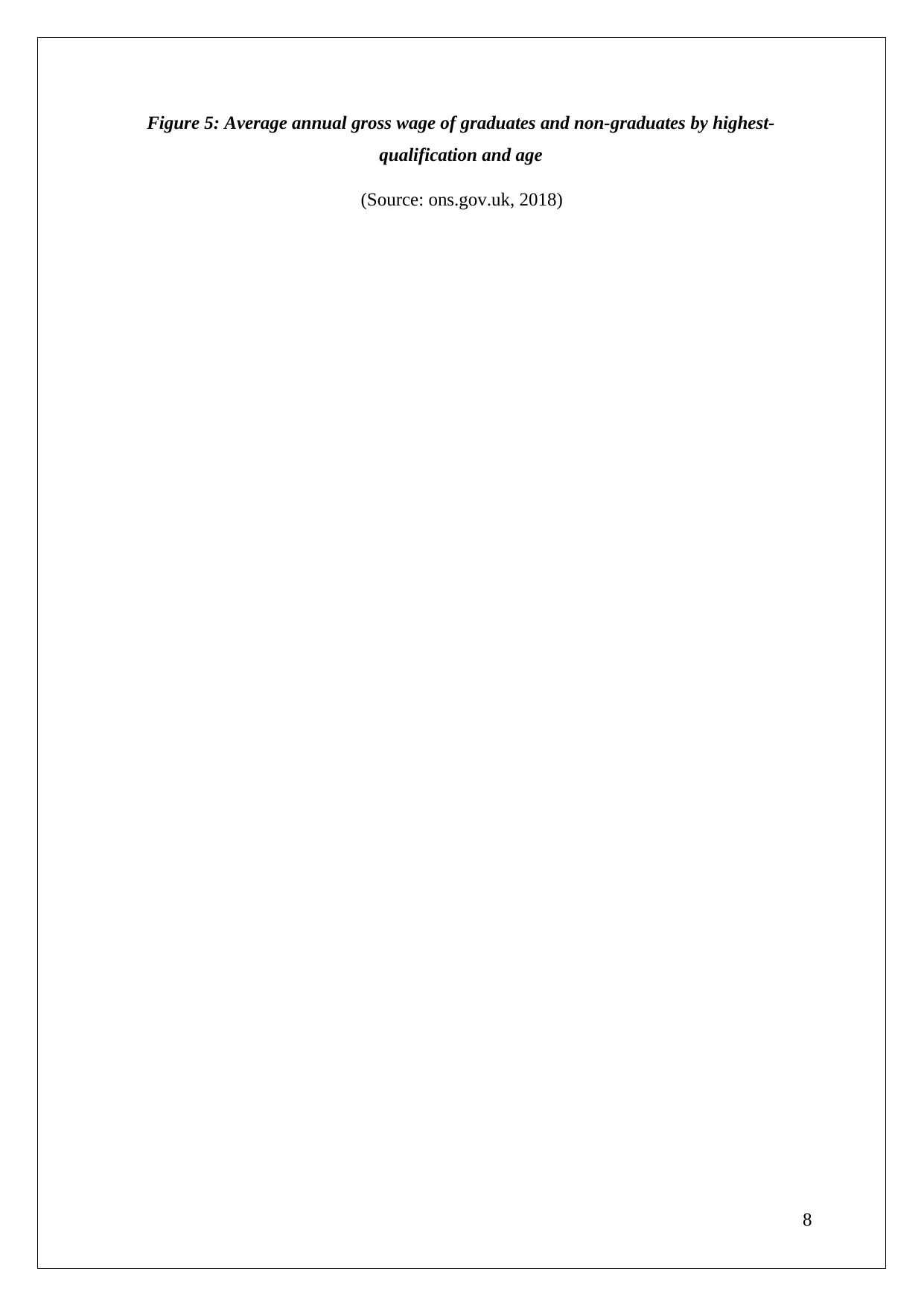
Figure 5: Average annual gross wage of graduates and non-graduates by highest-
qualification and age
(Source: ons.gov.uk, 2018)
8
qualification and age
(Source: ons.gov.uk, 2018)
8
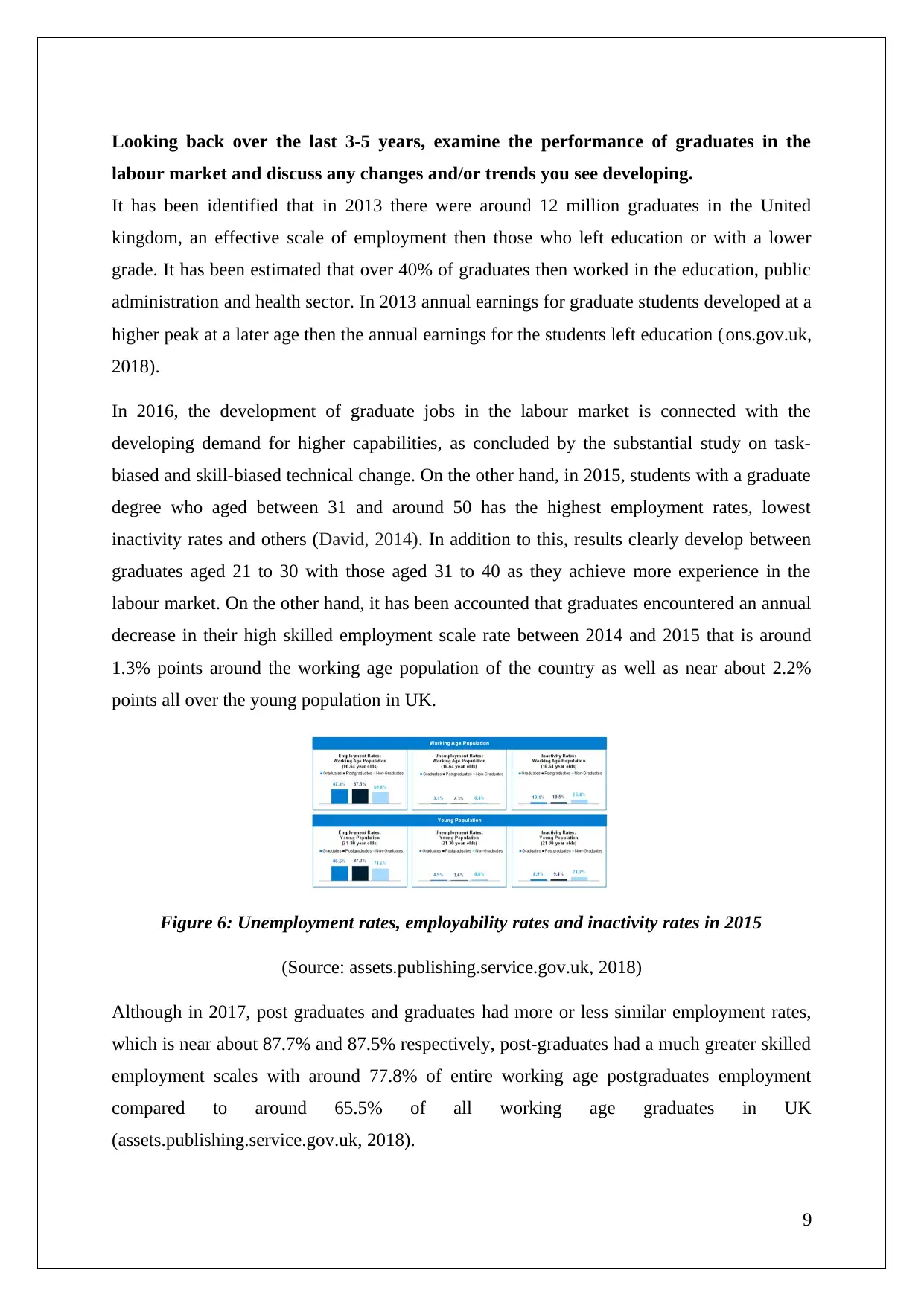
Looking back over the last 3-5 years, examine the performance of graduates in the
labour market and discuss any changes and/or trends you see developing.
It has been identified that in 2013 there were around 12 million graduates in the United
kingdom, an effective scale of employment then those who left education or with a lower
grade. It has been estimated that over 40% of graduates then worked in the education, public
administration and health sector. In 2013 annual earnings for graduate students developed at a
higher peak at a later age then the annual earnings for the students left education (ons.gov.uk,
2018).
In 2016, the development of graduate jobs in the labour market is connected with the
developing demand for higher capabilities, as concluded by the substantial study on task-
biased and skill-biased technical change. On the other hand, in 2015, students with a graduate
degree who aged between 31 and around 50 has the highest employment rates, lowest
inactivity rates and others (David, 2014). In addition to this, results clearly develop between
graduates aged 21 to 30 with those aged 31 to 40 as they achieve more experience in the
labour market. On the other hand, it has been accounted that graduates encountered an annual
decrease in their high skilled employment scale rate between 2014 and 2015 that is around
1.3% points around the working age population of the country as well as near about 2.2%
points all over the young population in UK.
Figure 6: Unemployment rates, employability rates and inactivity rates in 2015
(Source: assets.publishing.service.gov.uk, 2018)
Although in 2017, post graduates and graduates had more or less similar employment rates,
which is near about 87.7% and 87.5% respectively, post-graduates had a much greater skilled
employment scales with around 77.8% of entire working age postgraduates employment
compared to around 65.5% of all working age graduates in UK
(assets.publishing.service.gov.uk, 2018).
9
labour market and discuss any changes and/or trends you see developing.
It has been identified that in 2013 there were around 12 million graduates in the United
kingdom, an effective scale of employment then those who left education or with a lower
grade. It has been estimated that over 40% of graduates then worked in the education, public
administration and health sector. In 2013 annual earnings for graduate students developed at a
higher peak at a later age then the annual earnings for the students left education (ons.gov.uk,
2018).
In 2016, the development of graduate jobs in the labour market is connected with the
developing demand for higher capabilities, as concluded by the substantial study on task-
biased and skill-biased technical change. On the other hand, in 2015, students with a graduate
degree who aged between 31 and around 50 has the highest employment rates, lowest
inactivity rates and others (David, 2014). In addition to this, results clearly develop between
graduates aged 21 to 30 with those aged 31 to 40 as they achieve more experience in the
labour market. On the other hand, it has been accounted that graduates encountered an annual
decrease in their high skilled employment scale rate between 2014 and 2015 that is around
1.3% points around the working age population of the country as well as near about 2.2%
points all over the young population in UK.
Figure 6: Unemployment rates, employability rates and inactivity rates in 2015
(Source: assets.publishing.service.gov.uk, 2018)
Although in 2017, post graduates and graduates had more or less similar employment rates,
which is near about 87.7% and 87.5% respectively, post-graduates had a much greater skilled
employment scales with around 77.8% of entire working age postgraduates employment
compared to around 65.5% of all working age graduates in UK
(assets.publishing.service.gov.uk, 2018).
9
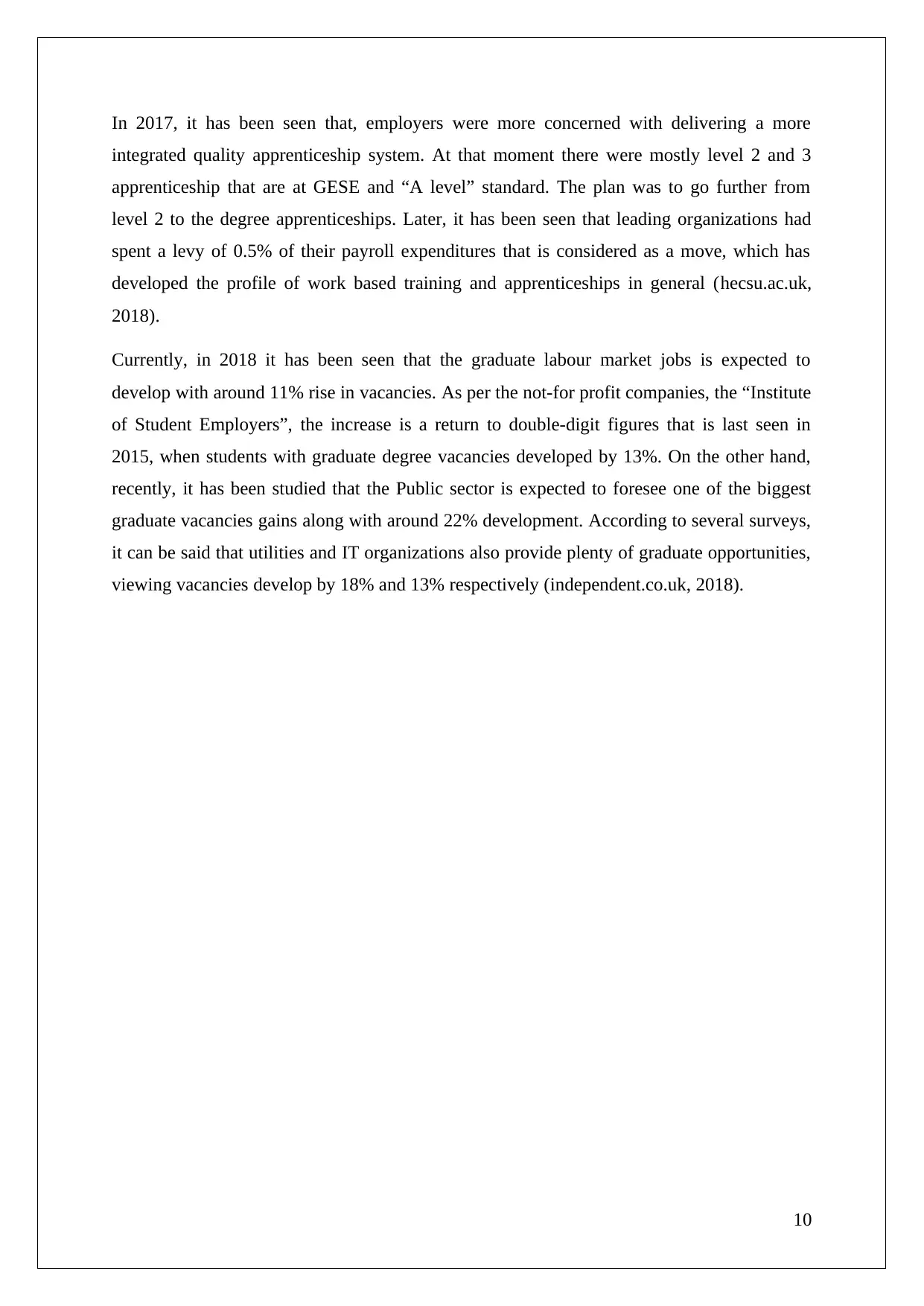
In 2017, it has been seen that, employers were more concerned with delivering a more
integrated quality apprenticeship system. At that moment there were mostly level 2 and 3
apprenticeship that are at GESE and “A level” standard. The plan was to go further from
level 2 to the degree apprenticeships. Later, it has been seen that leading organizations had
spent a levy of 0.5% of their payroll expenditures that is considered as a move, which has
developed the profile of work based training and apprenticeships in general (hecsu.ac.uk,
2018).
Currently, in 2018 it has been seen that the graduate labour market jobs is expected to
develop with around 11% rise in vacancies. As per the not-for profit companies, the “Institute
of Student Employers”, the increase is a return to double-digit figures that is last seen in
2015, when students with graduate degree vacancies developed by 13%. On the other hand,
recently, it has been studied that the Public sector is expected to foresee one of the biggest
graduate vacancies gains along with around 22% development. According to several surveys,
it can be said that utilities and IT organizations also provide plenty of graduate opportunities,
viewing vacancies develop by 18% and 13% respectively (independent.co.uk, 2018).
10
integrated quality apprenticeship system. At that moment there were mostly level 2 and 3
apprenticeship that are at GESE and “A level” standard. The plan was to go further from
level 2 to the degree apprenticeships. Later, it has been seen that leading organizations had
spent a levy of 0.5% of their payroll expenditures that is considered as a move, which has
developed the profile of work based training and apprenticeships in general (hecsu.ac.uk,
2018).
Currently, in 2018 it has been seen that the graduate labour market jobs is expected to
develop with around 11% rise in vacancies. As per the not-for profit companies, the “Institute
of Student Employers”, the increase is a return to double-digit figures that is last seen in
2015, when students with graduate degree vacancies developed by 13%. On the other hand,
recently, it has been studied that the Public sector is expected to foresee one of the biggest
graduate vacancies gains along with around 22% development. According to several surveys,
it can be said that utilities and IT organizations also provide plenty of graduate opportunities,
viewing vacancies develop by 18% and 13% respectively (independent.co.uk, 2018).
10
Secure Best Marks with AI Grader
Need help grading? Try our AI Grader for instant feedback on your assignments.
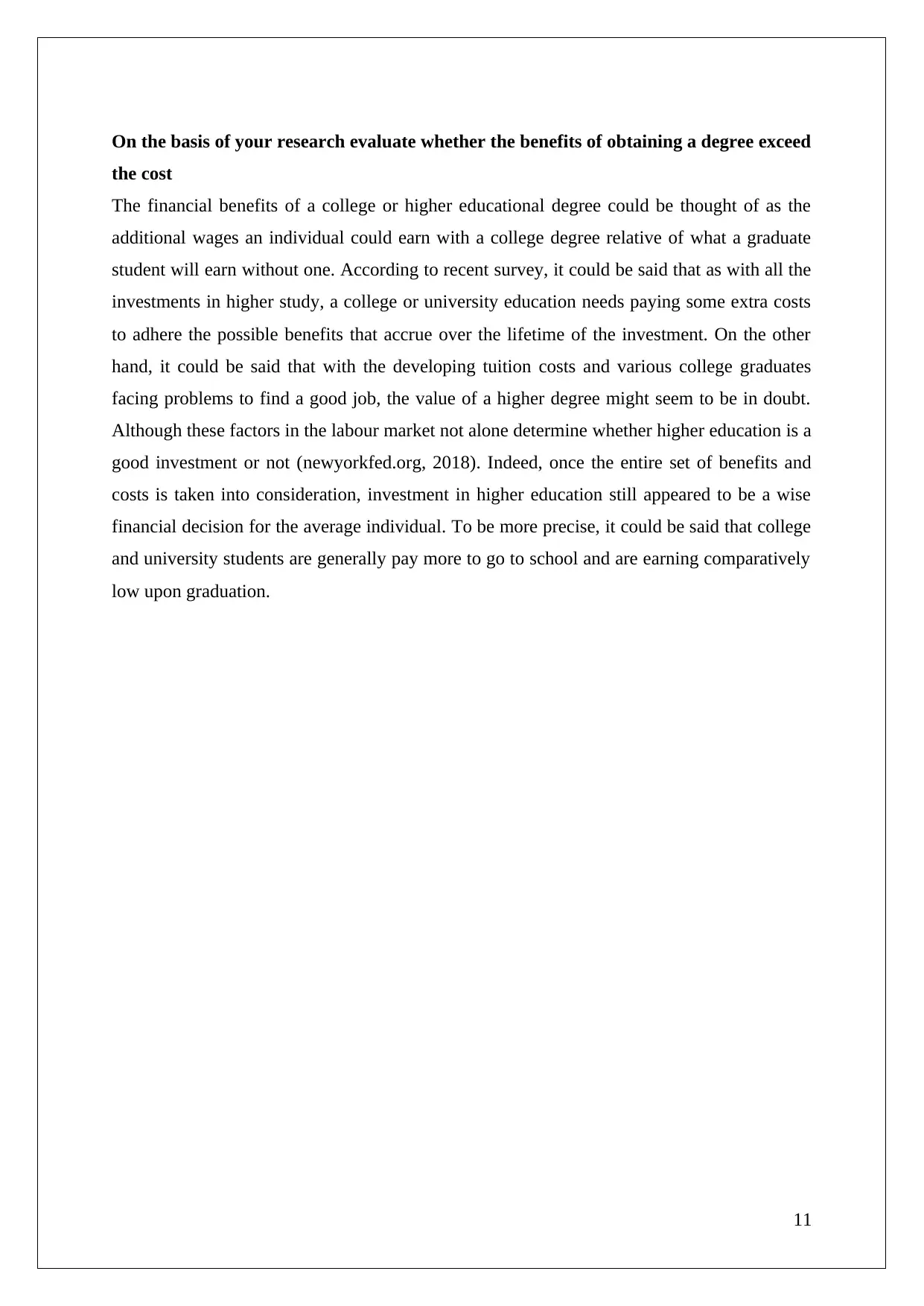
On the basis of your research evaluate whether the benefits of obtaining a degree exceed
the cost
The financial benefits of a college or higher educational degree could be thought of as the
additional wages an individual could earn with a college degree relative of what a graduate
student will earn without one. According to recent survey, it could be said that as with all the
investments in higher study, a college or university education needs paying some extra costs
to adhere the possible benefits that accrue over the lifetime of the investment. On the other
hand, it could be said that with the developing tuition costs and various college graduates
facing problems to find a good job, the value of a higher degree might seem to be in doubt.
Although these factors in the labour market not alone determine whether higher education is a
good investment or not (newyorkfed.org, 2018). Indeed, once the entire set of benefits and
costs is taken into consideration, investment in higher education still appeared to be a wise
financial decision for the average individual. To be more precise, it could be said that college
and university students are generally pay more to go to school and are earning comparatively
low upon graduation.
11
the cost
The financial benefits of a college or higher educational degree could be thought of as the
additional wages an individual could earn with a college degree relative of what a graduate
student will earn without one. According to recent survey, it could be said that as with all the
investments in higher study, a college or university education needs paying some extra costs
to adhere the possible benefits that accrue over the lifetime of the investment. On the other
hand, it could be said that with the developing tuition costs and various college graduates
facing problems to find a good job, the value of a higher degree might seem to be in doubt.
Although these factors in the labour market not alone determine whether higher education is a
good investment or not (newyorkfed.org, 2018). Indeed, once the entire set of benefits and
costs is taken into consideration, investment in higher education still appeared to be a wise
financial decision for the average individual. To be more precise, it could be said that college
and university students are generally pay more to go to school and are earning comparatively
low upon graduation.
11
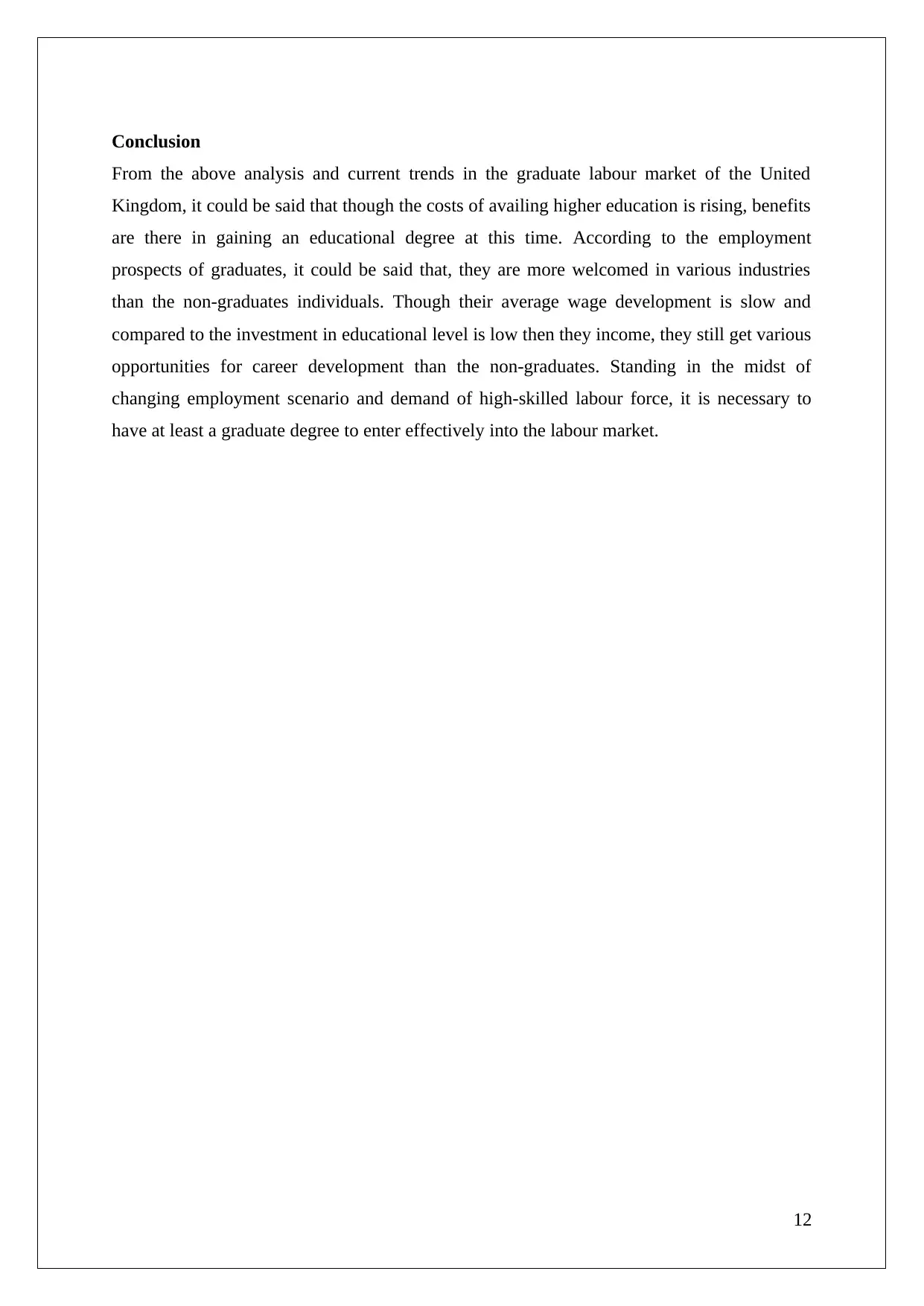
Conclusion
From the above analysis and current trends in the graduate labour market of the United
Kingdom, it could be said that though the costs of availing higher education is rising, benefits
are there in gaining an educational degree at this time. According to the employment
prospects of graduates, it could be said that, they are more welcomed in various industries
than the non-graduates individuals. Though their average wage development is slow and
compared to the investment in educational level is low then they income, they still get various
opportunities for career development than the non-graduates. Standing in the midst of
changing employment scenario and demand of high-skilled labour force, it is necessary to
have at least a graduate degree to enter effectively into the labour market.
12
From the above analysis and current trends in the graduate labour market of the United
Kingdom, it could be said that though the costs of availing higher education is rising, benefits
are there in gaining an educational degree at this time. According to the employment
prospects of graduates, it could be said that, they are more welcomed in various industries
than the non-graduates individuals. Though their average wage development is slow and
compared to the investment in educational level is low then they income, they still get various
opportunities for career development than the non-graduates. Standing in the midst of
changing employment scenario and demand of high-skilled labour force, it is necessary to
have at least a graduate degree to enter effectively into the labour market.
12
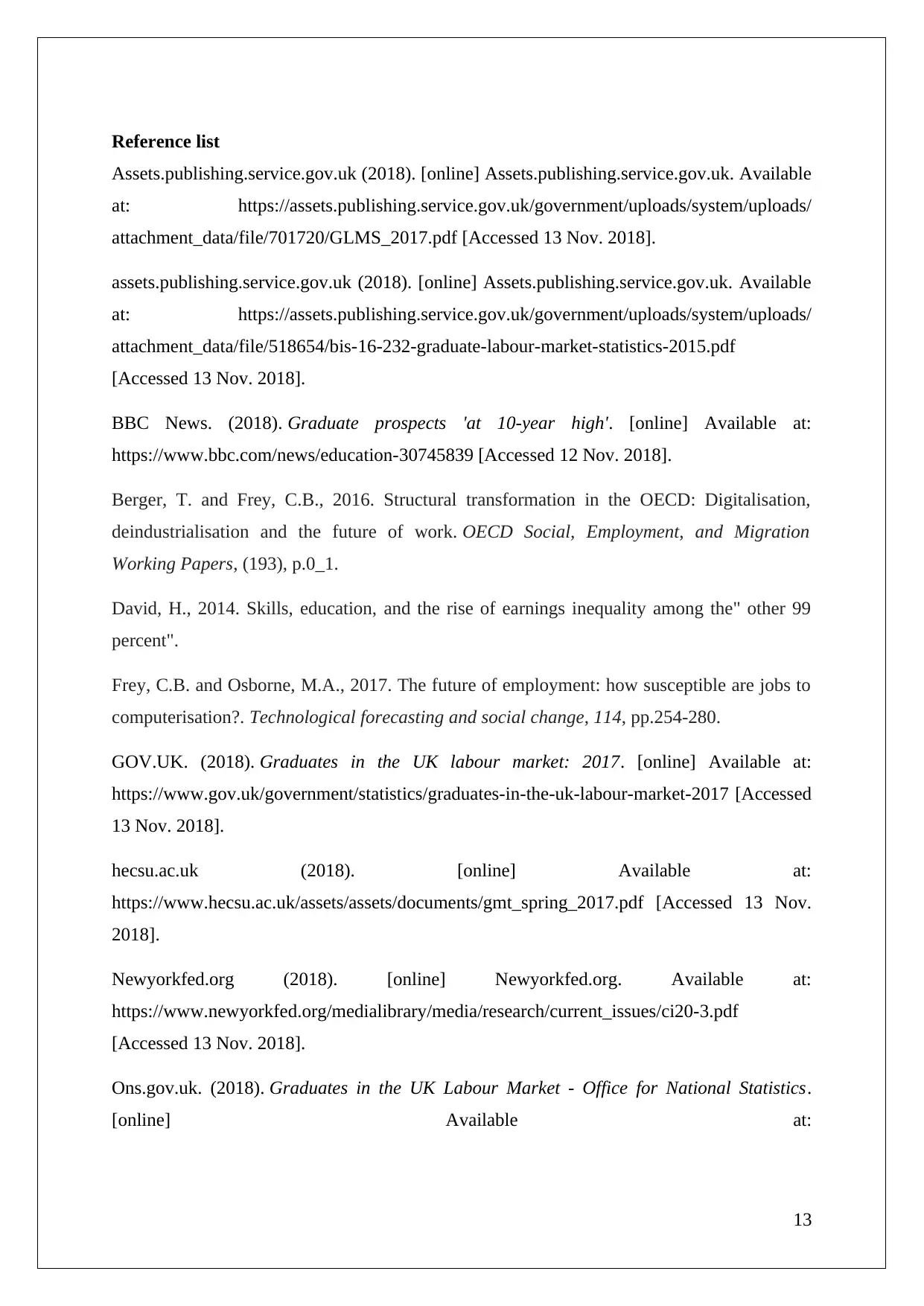
Reference list
Assets.publishing.service.gov.uk (2018). [online] Assets.publishing.service.gov.uk. Available
at: https://assets.publishing.service.gov.uk/government/uploads/system/uploads/
attachment_data/file/701720/GLMS_2017.pdf [Accessed 13 Nov. 2018].
assets.publishing.service.gov.uk (2018). [online] Assets.publishing.service.gov.uk. Available
at: https://assets.publishing.service.gov.uk/government/uploads/system/uploads/
attachment_data/file/518654/bis-16-232-graduate-labour-market-statistics-2015.pdf
[Accessed 13 Nov. 2018].
BBC News. (2018). Graduate prospects 'at 10-year high'. [online] Available at:
https://www.bbc.com/news/education-30745839 [Accessed 12 Nov. 2018].
Berger, T. and Frey, C.B., 2016. Structural transformation in the OECD: Digitalisation,
deindustrialisation and the future of work. OECD Social, Employment, and Migration
Working Papers, (193), p.0_1.
David, H., 2014. Skills, education, and the rise of earnings inequality among the" other 99
percent".
Frey, C.B. and Osborne, M.A., 2017. The future of employment: how susceptible are jobs to
computerisation?. Technological forecasting and social change, 114, pp.254-280.
GOV.UK. (2018). Graduates in the UK labour market: 2017. [online] Available at:
https://www.gov.uk/government/statistics/graduates-in-the-uk-labour-market-2017 [Accessed
13 Nov. 2018].
hecsu.ac.uk (2018). [online] Available at:
https://www.hecsu.ac.uk/assets/assets/documents/gmt_spring_2017.pdf [Accessed 13 Nov.
2018].
Newyorkfed.org (2018). [online] Newyorkfed.org. Available at:
https://www.newyorkfed.org/medialibrary/media/research/current_issues/ci20-3.pdf
[Accessed 13 Nov. 2018].
Ons.gov.uk. (2018). Graduates in the UK Labour Market - Office for National Statistics.
[online] Available at:
13
Assets.publishing.service.gov.uk (2018). [online] Assets.publishing.service.gov.uk. Available
at: https://assets.publishing.service.gov.uk/government/uploads/system/uploads/
attachment_data/file/701720/GLMS_2017.pdf [Accessed 13 Nov. 2018].
assets.publishing.service.gov.uk (2018). [online] Assets.publishing.service.gov.uk. Available
at: https://assets.publishing.service.gov.uk/government/uploads/system/uploads/
attachment_data/file/518654/bis-16-232-graduate-labour-market-statistics-2015.pdf
[Accessed 13 Nov. 2018].
BBC News. (2018). Graduate prospects 'at 10-year high'. [online] Available at:
https://www.bbc.com/news/education-30745839 [Accessed 12 Nov. 2018].
Berger, T. and Frey, C.B., 2016. Structural transformation in the OECD: Digitalisation,
deindustrialisation and the future of work. OECD Social, Employment, and Migration
Working Papers, (193), p.0_1.
David, H., 2014. Skills, education, and the rise of earnings inequality among the" other 99
percent".
Frey, C.B. and Osborne, M.A., 2017. The future of employment: how susceptible are jobs to
computerisation?. Technological forecasting and social change, 114, pp.254-280.
GOV.UK. (2018). Graduates in the UK labour market: 2017. [online] Available at:
https://www.gov.uk/government/statistics/graduates-in-the-uk-labour-market-2017 [Accessed
13 Nov. 2018].
hecsu.ac.uk (2018). [online] Available at:
https://www.hecsu.ac.uk/assets/assets/documents/gmt_spring_2017.pdf [Accessed 13 Nov.
2018].
Newyorkfed.org (2018). [online] Newyorkfed.org. Available at:
https://www.newyorkfed.org/medialibrary/media/research/current_issues/ci20-3.pdf
[Accessed 13 Nov. 2018].
Ons.gov.uk. (2018). Graduates in the UK Labour Market - Office for National Statistics.
[online] Available at:
13
Paraphrase This Document
Need a fresh take? Get an instant paraphrase of this document with our AI Paraphraser
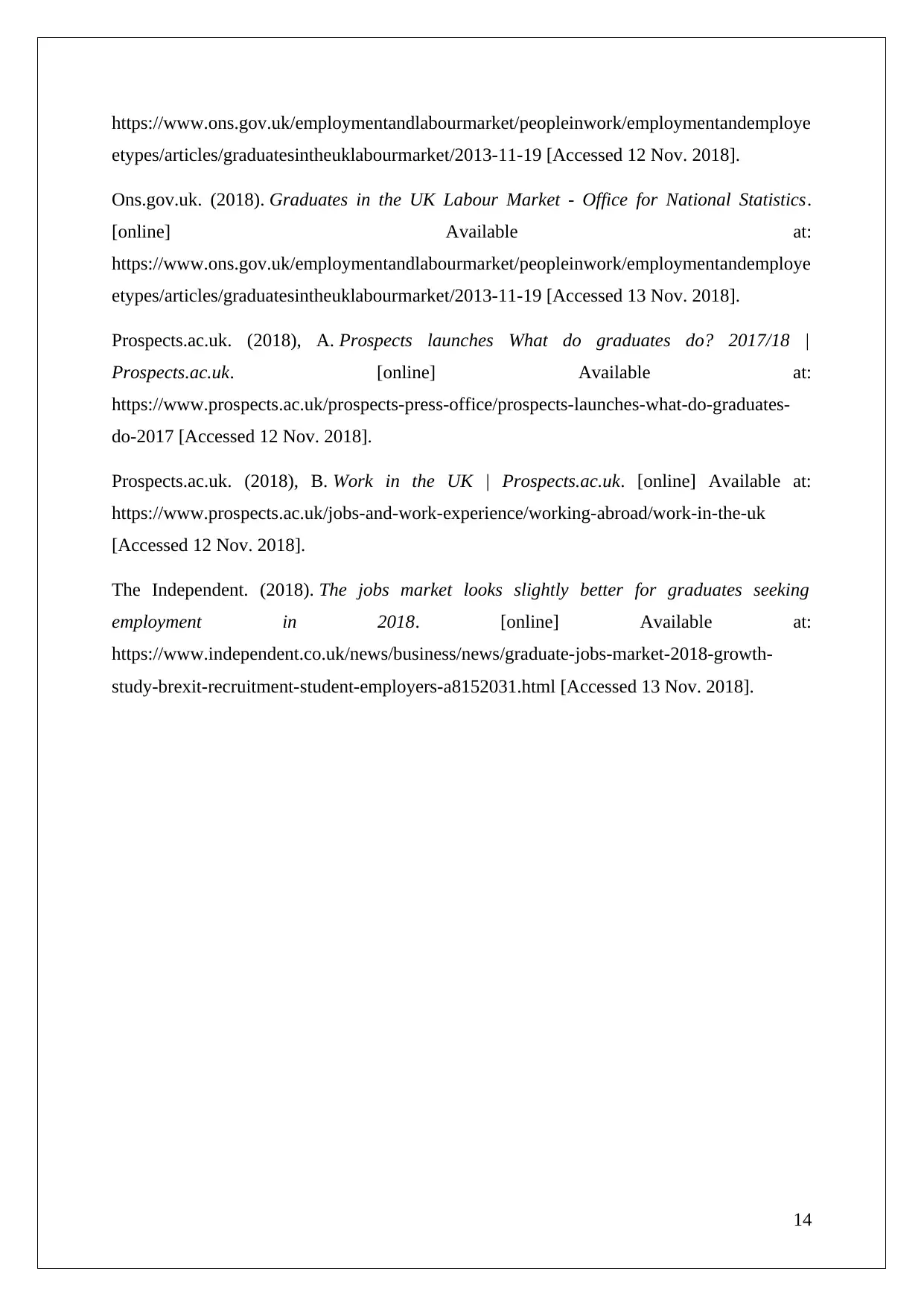
https://www.ons.gov.uk/employmentandlabourmarket/peopleinwork/employmentandemploye
etypes/articles/graduatesintheuklabourmarket/2013-11-19 [Accessed 12 Nov. 2018].
Ons.gov.uk. (2018). Graduates in the UK Labour Market - Office for National Statistics.
[online] Available at:
https://www.ons.gov.uk/employmentandlabourmarket/peopleinwork/employmentandemploye
etypes/articles/graduatesintheuklabourmarket/2013-11-19 [Accessed 13 Nov. 2018].
Prospects.ac.uk. (2018), A. Prospects launches What do graduates do? 2017/18 |
Prospects.ac.uk. [online] Available at:
https://www.prospects.ac.uk/prospects-press-office/prospects-launches-what-do-graduates-
do-2017 [Accessed 12 Nov. 2018].
Prospects.ac.uk. (2018), B. Work in the UK | Prospects.ac.uk. [online] Available at:
https://www.prospects.ac.uk/jobs-and-work-experience/working-abroad/work-in-the-uk
[Accessed 12 Nov. 2018].
The Independent. (2018). The jobs market looks slightly better for graduates seeking
employment in 2018. [online] Available at:
https://www.independent.co.uk/news/business/news/graduate-jobs-market-2018-growth-
study-brexit-recruitment-student-employers-a8152031.html [Accessed 13 Nov. 2018].
14
etypes/articles/graduatesintheuklabourmarket/2013-11-19 [Accessed 12 Nov. 2018].
Ons.gov.uk. (2018). Graduates in the UK Labour Market - Office for National Statistics.
[online] Available at:
https://www.ons.gov.uk/employmentandlabourmarket/peopleinwork/employmentandemploye
etypes/articles/graduatesintheuklabourmarket/2013-11-19 [Accessed 13 Nov. 2018].
Prospects.ac.uk. (2018), A. Prospects launches What do graduates do? 2017/18 |
Prospects.ac.uk. [online] Available at:
https://www.prospects.ac.uk/prospects-press-office/prospects-launches-what-do-graduates-
do-2017 [Accessed 12 Nov. 2018].
Prospects.ac.uk. (2018), B. Work in the UK | Prospects.ac.uk. [online] Available at:
https://www.prospects.ac.uk/jobs-and-work-experience/working-abroad/work-in-the-uk
[Accessed 12 Nov. 2018].
The Independent. (2018). The jobs market looks slightly better for graduates seeking
employment in 2018. [online] Available at:
https://www.independent.co.uk/news/business/news/graduate-jobs-market-2018-growth-
study-brexit-recruitment-student-employers-a8152031.html [Accessed 13 Nov. 2018].
14
1 out of 14
Related Documents
Your All-in-One AI-Powered Toolkit for Academic Success.
+13062052269
info@desklib.com
Available 24*7 on WhatsApp / Email
![[object Object]](/_next/static/media/star-bottom.7253800d.svg)
Unlock your academic potential
© 2024 | Zucol Services PVT LTD | All rights reserved.





